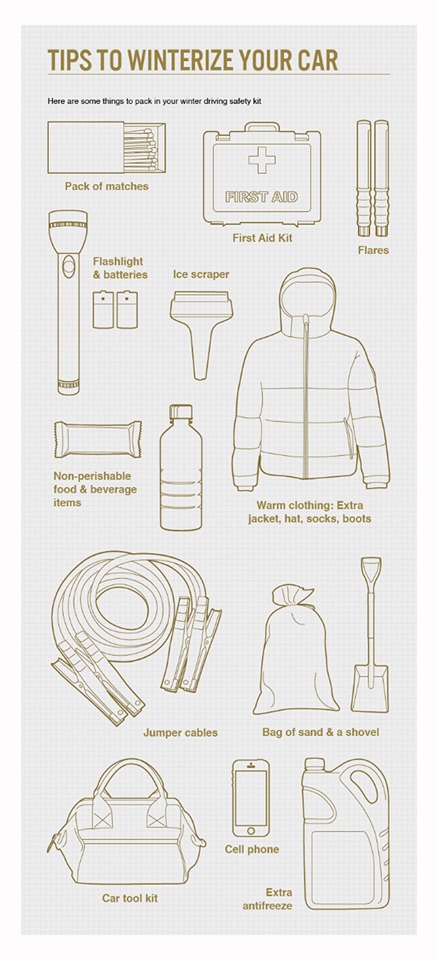
Winter Driving Greeley Colorado
Tue, Dec 03, 2019

Helpful Winter Tips to Keep You Safe
1. HAVE YOUR CAR SERVICED FOR WINTER CONDITIONS
Before you hit any harsh winter conditions, have your vehicle serviced to prepare it for the challenges winter can pose.
~Battery – Battery power decreases as the temperature drops, meaning that it takes more power to start your car in the winter. If your
battery is already having problems, your risk of breaking down increases. It is recommended that your auto care provider installs a battery at
or above 600 CCA for optimal winter performance.
~Cooling system – It is recommended to maintain a ratio between 50/50 and 70/30 of antifreeze to water. Ask your technician what
antifreeze should be used for your vehicle and the appropriate coolant-to-water ratio to prevent against corrosion and potential freezing.
~Brakes – While cold weather doesn’t necessarily hurt your brakes, a thorough inspection can ensure the best performance when driving in
winter conditions.
~Belts, hoses, spark plugs, wires and cables – These can go bad at any time of year, but if they go bad during the winter, you could be
stranded in a very cold place for a very long time.
2. SWITCH TO WINTER TIRES
It’s possible to use all-season tires in winter conditions however, this won’t offer you the maximum performance you may need in your
environment.
If you live in a place that experiences extremely cold winter temperatures, it is recommended that you install winter tires when winterizing
your car. When the temperature consistently hovers around or below freezing, the rubber compounds in non-winter tires harden, decreasing
the tire’s ability to grip the road. Winter tires use special compounds engineered to resist hardening in cold temperatures, providing better
traction in ice, snow, slush, and even dry pavement.
If you live in an area that doesn’t normally have intense winters, all-season tires should be acceptable. However, if you live somewhere with
harsh winters or regularly visit places that do, winter tires are the safest choice for you.
3. MAINTAIN TIRE PRESSURE
Every 10° change in ambient temperature could mean a gain or loss of 1 PSI. This means you should check pressure more regularly during
winter and refill your tires as needed. Appropriate pressure for your tires can be found on the tire placard in the driver’s side door jamb or in
your vehicle owner’s manual.

4. CHECK FOR CHANGING TEMPERATURES THAT COULD AFFECT TRACTION
Before going out for a long winter drive, check to see how temperatures may change while you’re out. Changing temperatures can affect both
your traction and driving ability if there is a sudden change that you’re not prepared for.
For example, how you should drive in 0° weather is much different than how you can drive in 32° weather. You generally have better traction
at 0° than you do at 32° due to surfaces becoming more slippery at these higher winter temperatures.
5. INSTALL WINTER WIPERS
These come equipped with rubber that keeps ice from collecting on the blades. Just be sure to remove them when spring rolls around. As
winter wipers are heavier than regular ones, keeping them on all the time increases the load on the wiper motor.
6. KEEP WASHER FLUID FULL
Replace your windshield wiper fluid often. A single snowstorm can exhaust a large amount of this fluid, so refill the washer reservoir
frequently with windshield wiper fluid formulated for winter conditions. If you’re unsure if your washer fluid is the right formula for low
temperatures, add a bottle of washer fluid antifreeze to the reservoir. You’ll find it at most auto parts stores.
7. PACK A WINTER SAFETY KIT
Before heading off on a trip, store common tools and supplies in your car in case of an emergency. Use this infographic below to know what to
pack before heading out into the snow.

8. KEEP THE GAS TANK AT LEAST HALF FULL
Fill up often! Keeping gas in the tank is more important in winter than in summer. Why? For one thing, a full tank reduces condensation, which
can prevent gas line freeze ups. Not only that, but if you’re ever stranded, your engine may be the only thing to keep you warm until help
arrives.
9. KEEP YOUR REAR-WINDOW DEFROSTER IN WORKING ORDER
Being unable to see behind you could create unsafe driving conditions. That’s why several states have laws stating that all your windows must
be clear of condensation and debris. When winterizing your car, check your rear-window defroster before cold weather arrives to be sure it’s
working properly.
10. LEARN WINTER EMERGENCY PREPAREDNESS
It’s important to know what to do before you are in an emergency in case you ever get stuck. If you get stuck in a winter storm while driving:
~Do not leave your car for risk of losing sight of it
~Do not run your car for long periods of time. Instead, turn it on long enough to stay warm, and then turn it off again to avoid carbon
monoxide poisoning
~Put your dome lights on to attract attention
11. LEARN HOW-TO DRIVE IN WINTER CONDITIONS
It’s best to know how-to drive in winter conditions before getting on snowy or icy roads. If you need any hands-on help, contact your local
driving school to assist:
~What gear to drive in on snow and ice
~How fast you should drive
~Stopping distance you need between vehicles
~What to do if you start sliding
~Driving uphill or downhill
If you need anything during this
winter season, please feel free to
stop by or contact us.
Please Drive Safe

